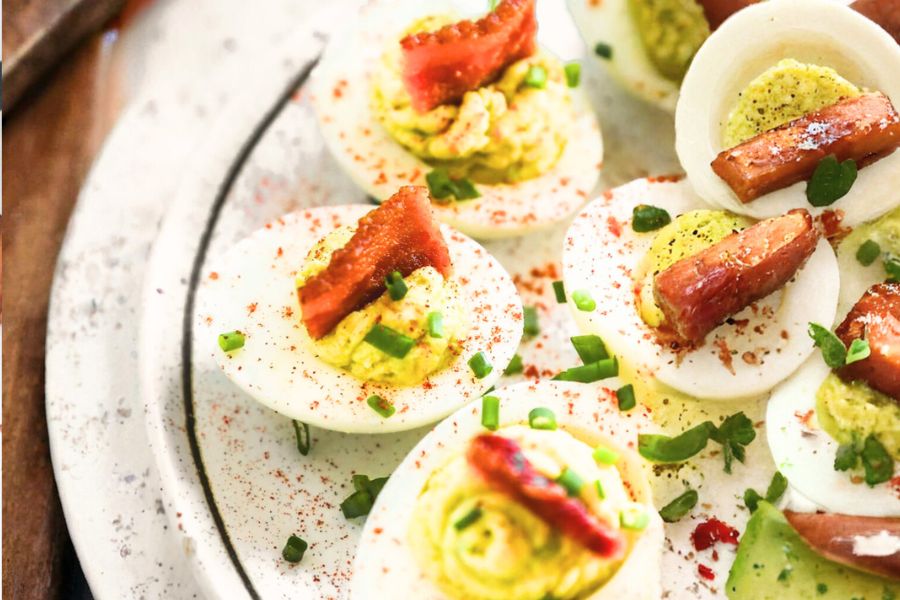This Avocado Deviled Eggs recipe uniquely combines creamy avocado with classic deviled eggs, creating a delicious twist that’s both satisfying and nutritious.
The avocado adds a rich source of heart-healthy monounsaturated fats and fiber, while the eggs contribute high-quality protein, making this dish a balanced, nutrient-dense snack or appetizer.

It’s naturally low in carbs and saturated fat, making it ideal for those seeking a wholesome, low-carb option.
Beyond health, the recipe is quick and straightforward, requiring minimal prep and cook time, perfect for busy weeknights or entertaining guests.
The optional crispy bacon adds a savory crunch that elevates the flavors without overwhelming the freshness of the avocado.
Its versatility as a make-ahead appetizer (with minor timing considerations) and its crowd-pleasing nature make it an excellent choice for everyday meals or special occasions.
Must-Have Tools for Perfect Results
Medium Pot
Essential for gently simmering eggs to perfection. A good-quality pot ensures even heat distribution, preventing cracking and ensuring consistent cooking, a staple for any kitchen.
Slotted Spoon
Ideal for carefully transferring eggs between boiling water and ice bath, minimizing shell breakage. Its precision is invaluable for delicate tasks.
Mixing Bowl
Provides ample space for mashing and mixing the yolk and avocado filling smoothly. Durable bowls are versatile for countless cooking tasks.
Piping Bag (or Zip-top Bag)
Enables elegant presentation by piping the creamy filling into egg whites, enhancing aesthetics effortlessly. Also useful for decorating baked goods.
Sharp Knife
Crucial for halving eggs neatly and chopping bacon and chives with precision. A sharp, reliable knife is fundamental in every kitchen

30-Minute Avocado Deviled Eggs
Equipment
- 1 medium pot
- 1 Slotted Spoon
- 1 Mixing Bowl
- 1 Piping Bag or Zip-top Bag
- 1 Sharp Knife
Ingredients
- 6 large eggs
- 1 ripe avocado
- 1 tablespoon fresh lemon juice
- ¼ teaspoon kosher salt plus extra to taste
- ⅛ teaspoon garlic powder
- 1 tablespoon plain Greek yogurt or sour cream
- 2 slices cooked bacon chopped into small pieces (optional)
- Fresh chives finely chopped, for garnish
- Smoked paprika or regular paprika for sprinkling (optional)
Instructions
- Prepare the Eggs for Hard Boiling: Begin by placing a medium-sized pot on the stove and fill it with enough water to cover the eggs by at least an inch or two. Bring the water to a gentle boil over medium-high heat. While waiting, gather your eggs and a slotted spoon for handling them safely. Once the water reaches a gentle boil, carefully lower the eggs into the pot one at a time using the slotted spoon to avoid cracking. Adjust the heat immediately to maintain a steady simmer — you want the water bubbling lightly but not roaring vigorously, which can cause the eggs to bounce and crack.
- Simmer the Eggs Perfectly: Allow the eggs to simmer gently for 8 to 9 minutes. This timing ensures the yolks cook fully but remain tender and creamy, avoiding the dreaded greenish ring. While the eggs cook, prepare an ice bath by filling a large bowl with cold water and plenty of ice cubes. The ice bath will stop the cooking process instantly once the eggs are done, preventing overcooking.
- Cool and Crack the Eggs: Using your slotted spoon, carefully transfer the hot eggs from the simmering water into the ice bath. Let them chill for at least 5 minutes or until fully cooled. After cooling, gently tap each egg on a hard surface to crack the shell all over. For easier peeling, you can place the cracked eggs back into the cold water briefly. This water helps loosen the shell from the egg white, making peeling smoother and quicker.
- Peel and Halve the Eggs: Once cooled and cracked, peel the eggs carefully to avoid tearing the whites. Using a sharp knife, slice each egg lengthwise into two equal halves. Arrange the empty egg white halves on a serving platter with the hollow side facing up, creating little “boats” ready to be filled.
- Prepare the Avocado-Yolk Filling: Scoop the cooked yolks out of the eggs and place them into a medium mixing bowl. Add the ripe avocado flesh to the bowl as well. To brighten the flavors and keep the avocado from browning, pour in the fresh lemon juice. Sprinkle in the kosher salt and garlic powder, then add the Greek yogurt or sour cream for extra creaminess. Using a fork, mash and mix all ingredients together thoroughly until the mixture is smooth and silky. Take a moment to taste the filling and adjust the seasoning, adding a pinch more salt if needed.
- Fill the Egg Whites with the Mixture: For a neat and attractive presentation, transfer the creamy avocado-yolk mixture into a piping bag or a zip-top plastic bag with one corner snipped off. Gently pipe or spoon the filling into each egg white half, filling the hollows generously but cleanly. The piping technique helps create a decorative swirl, elevating the look of your deviled eggs.
- Add the Finishing Touches: If using bacon, tuck a small piece into each filled egg half like a flavorful flag. Sprinkle the chopped fresh chives evenly over the top for a burst of color and mild onion flavor. Finish with a light dusting of smoked paprika or regular paprika to add a subtle smoky aroma and a pop of vibrant red color.
- Serve or Store Thoughtfully : Serve these avocado deviled eggs immediately for best flavor and appearance. If preparing ahead, keep the filling and egg whites separate until close to serving time to prevent browning. Cover assembled eggs loosely with plastic wrap to minimize air contact.Enjoy as a satisfying appetizer, snack, or party favorite!
Notes
- To cook the eggs, you can use traditional boiling methods or try alternatives like the air fryer or Instant Pot for convenience.
- This recipe is best served fresh because the avocado filling may brown if left too long. For best results, prepare the filling shortly before serving and fill the egg whites just before plating.
- Leftover deviled eggs with avocado don’t keep well due to oxidation, but you can slow browning by covering the eggs tightly with plastic wrap to limit air exposure.
- If you want to save time, boil the eggs in advance and refrigerate them, peeling right before assembling the deviled eggs.
Chef’s Secrets for Ultimate Flavor
To elevate your avocado deviled eggs to the next level, timing and ingredient freshness are key.
Always use ripe but firm avocados—they should yield slightly to gentle pressure without feeling mushy.
This ensures a creamy filling with just the right texture. Adding fresh lemon juice not only brightens the flavor but also helps prevent the avocado from browning too quickly.
When boiling eggs, simmer gently rather than boiling vigorously; this prevents cracking and yields tender whites and perfectly cooked yolks.
For an elegant presentation, piping the filling instead of spooning it creates beautiful swirls and keeps portions consistent. Lastly, crispy bacon is optional but highly recommended—it adds a satisfying crunch and a savory contrast to the creamy filling.
Serving Suggestions That Impress Guests
Avocado deviled eggs shine as a versatile appetizer or snack.
Serve them chilled on a decorative platter garnished with chopped chives and a light dusting of smoked paprika for an eye-catching finish.
Pair them with fresh vegetable crudités or a crisp green salad for a balanced, colorful spread. They also make a great addition to brunch menus alongside smoked salmon, bagels, or fresh fruit.
For parties, consider offering a variety of toppings—such as diced tomatoes, pickled jalapeños, or crumbled feta—to let guests customize their bites.
These eggs are perfect finger food, making them a crowd-pleaser at casual get-togethers and elegant dinners alike.
Storage Tips to Preserve Freshness
Because avocado browns quickly when exposed to air, it’s best to assemble these deviled eggs close to serving time.
If you need to prepare them in advance, keep the avocado-yolk filling in an airtight container with plastic wrap pressed directly onto the surface to minimize oxidation.
Refrigerate separately from the egg whites and fill them just before serving. If already assembled, cover the platter tightly with plastic wrap to limit air exposure.
Leftovers should be consumed within 24 hours, as the texture and appearance deteriorate rapidly.
While browned filling is safe to eat, it’s less visually appealing, so fresh preparation is always preferred for the best experience.
Frequently Asked Questions About Recipe
1. Can I use mayonnaise instead of Greek yogurt?
Yes, mayonnaise can be substituted for Greek yogurt or sour cream, but it will increase the fat content and change the flavor profile slightly. Greek yogurt adds tanginess and a protein boost while keeping the recipe lighter.
2. How do I know when an avocado is perfectly ripe?
A ripe avocado should yield to gentle pressure without feeling overly soft or mushy. If it’s too firm, it’s not ripe yet; too soft indicates overripeness, which can result in a bitter taste or watery texture.
3. Is it possible to make this recipe vegan?
To make a vegan version, substitute eggs with halved baby potatoes or firm tofu slices and use plant-based yogurt or sour cream alternatives. The avocado filling can remain largely the same but skip bacon or use plant-based bacon substitutes.
4. Can I freeze avocado deviled eggs?
Freezing is not recommended because the texture of avocado and eggs changes significantly after thawing, resulting in watery and mushy filling. It’s best enjoyed fresh.
5. What’s the best way to peel hard-boiled eggs easily?
Using older eggs (about a week old) helps the shell peel off more easily. After boiling, placing eggs in an ice bath and cracking the shell all over before peeling also makes the process smoother and reduces damage to the egg whites.
This recipe has been adapted and simplified from the original version by wellplated. We’ve refined the steps for a smoother cooking experience and added helpful notes, nutrition insights, and essential kitchen tools to make it even easier for home cooks.

